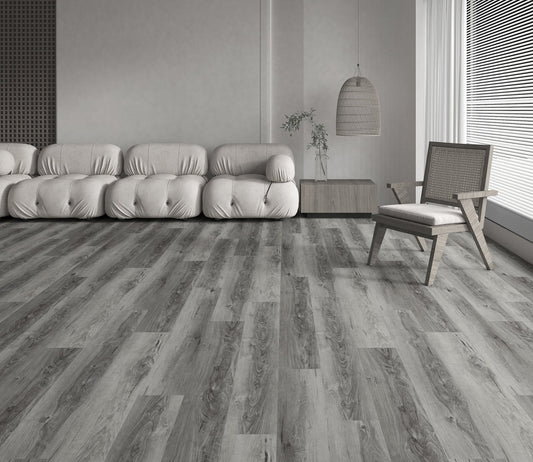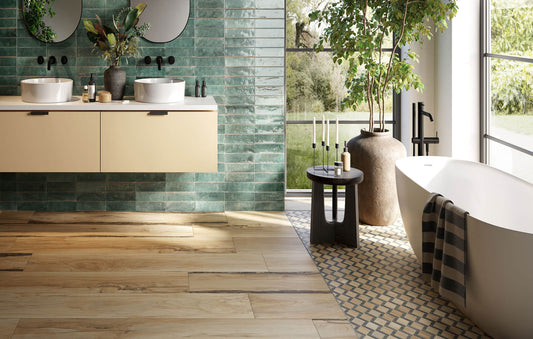At STS we have a deep commitment to providing innovative solutions to everyday challenges. To this end, we noticed a need for a new high-quality but low-priced alternative to flooring. If we were to make strides in this area then we had to address the weaknesses of the leading alternative at the time, Luxury Vinyl Tile (LVT).
Through extensive research and development our dream developed into our latest pride Nütile, a high-quality Stone Polymer Composite (SPC) that improves upon the properties of LVT, combining a wonderful aesthetic with a long-lasting and hard-wearing material at a reasonable and affordable price.
In this blog, we are going to explore the differences between SPC and LVT so you can make a more informed decision on your next flooring material.
SPC and LVT: What are they made of?
Both Stone Polymer Composite and Luxury Vinyl Tiles come in the form of planks that are put together through a process of layering. The salient difference between the two comes from the material used in their core, which forms the foundational structure of the planks.
LVT: LVT flooring uses a soft vinyl core, often with a cushioned backing underneath, and a high-resolution design printed on top with a protective layer to ensure the longevity of the design underneath.
Vinyl is a particular chemical term relating to a specific chemical makeup. This makeup can be found in many forms but is often found bonded to chlorine, making vinyl chloride. When mixed with the right starting ingredients, these single compounds begin to link together into long chains known as polymers, this produces the plastic that many of us know as 'polyvinyl chloride' or PVC.
PVC is soft and durable, meaning it has a nice amount of flex and the strongly bonded polymers hold together for many years without breaking down. With the added protective layer the PVC core and high-resolution design can withstand several years of daily wear and tear.
SPC: SPC flooring is what is known as a Stone Polymer Composite, the name is also its description. A composite is a material made up of pieces, and the pieces here are a mixture of natural stone, most often limestone, and a polymer, which is another term for plastic. The polymer in question is the same PVC you would find in LVT flooring, except PVC only makes up around 30% of the SPC, with the other 70% being natural stone.
This gives the core of SPC its enhanced properties that improve upon the softer planks of LVT. A stronger core simply means a greater resistance to impacts and temperature changes ensuring it has a greater lifespan which allows manufacturers to offer a longer warranty and guarantee of quality.
Waterproofing
Tiles have long been the material of choice for wet rooms and high-moisture areas such as bathrooms, kitchens, washrooms and utility rooms. If either LVT or SPC flooring are to replace tile as a stronger alternative then they must share the same waterproof properties.
Both LVT and SPC flooring have 100% waterproof cores along with their protective layers on top. Both PVC and natural stone are inherently waterproof so both tiling alternatives are happily at home in high moisture environments.
Durability and Longevity
When choosing an alternative to tiling it is important that our choice can stand the test of time, luckily this is where SPC flooring begins to outshine LVT.
Luxury Vinyl Tile has a soft vinyl core that is durable enough to last around 10-15 years of daily use. Whilst the softer core can offer a softer feel underfoot, which is a plus in terms of home comfort, it also makes LVT more vulnerable to damage from impacts. With a soft core, heavy objects are at risk of leaving dents and impressions when dropped, and the daily wear from footfall can begin to slowly compress the tile, warping its shape over time.
SPC flooring, such as Nütile, has a much stronger and more rigid core that is made of 70% natural stone. This ensures that the tiles stay rigid, unmarked, and undamaged for a much longer period of time. Even under heavy traffic and daily use a Stone Polymer Composite floor will continue to hold up and look the part for years to come. Which is why we offer a 25-year warranty on our Nüstone and Nüforest collections, provided they are installed properly in residential properties and are only installed indoors.
Whilst both LVT and SPC are durable and waterproof, prolonged outdoor exposure to sun and moisture will not allow either tiling alternative to perform at its greatest capacity, nor fulfil its potential in terms of longevity. So it is important to follow appropriate installation guidelines and manufacturer’s instructions in both cases.
Ease of Installation and Maintenance
The main differences between LVT and SPC flooring when it comes to installation are dependent upon the system the particular product uses.
It is far more common for LVT to require glueing into place, even if it also has a click-and-lock system. Furthermore, LVT may require an underlay too for cushioning or acoustic dampening which must be installed and fitted correctly prior to laying the LVT in place.
Our SPC Floorboards, however, come pre-fitted with a soft underlayer which provides cushioning and acoustic dampening to ensure it remains quiet underfoot, no matter who is dancing over its surface.
Our Nütile installation system is a simple click-and-lock process that is DIY-friendly and so ensures it can be fitted by yourself at home with no need for adhesives or complicated skills.
Once installed both LVT and SPC need to be maintained. In terms of cleaning and upkeep, there is little difference between the two. Their protective outer coatings ensure that as long as they are swept free of dirt and grit regularly, and washed and mopped with a Ph-neutral cleaner, they'll maintain their beautiful designs for the extent of their lifespan.
Aesthetics
So the final two comparators are between the price of LVT and SPC and the aesthetic choices either one can bring to your home.
On the aesthetic front, both SPC and LVT are evenly matched, using high-resolution designs layered over the core and protected with a resistant and UV-safe wear and tear layer. UV protection is required as pigments often fade over time when exposed to sunlight. Whilst extreme exposure can still cause some fading over long periods, such as if SPC flooring was used in a conservatory, for the general daily exposure to sunlight both products will keep their design looking fresh and bright for years to come.
It is common to find traditional designs that mimic wood and stone patterns. This was our choice of aesthetic when deciding on our Nüstone and Nüforest collections as we feel they are the most versatile, classy, and timeless, ensuring a wonderful natural look throughout your homes.
LVT and SPC can also be printed with more abstract and whacky designs and patterns, though this is less common and down to personal choices in aesthetics.
Pricing
In terms of pricing both LVT and SPC can cost a similar amount depending on the quality of manufacture, design, and respective installation system. The more complicated installation of LVT can offer a lower price point but also requires someone to install it properly and therefore costs are incurred elsewhere.
But when it comes to price over time then SPC flooring wins out every time thanks to its ability to last for around 10 years longer than LVT can.
So whilst you may pay a slightly higher price upfront, you will save that money over time by not having to replace it again for a long, long while.
Conclusion
And now we’ve sized up LVT flooring against SPC flooring we feel it’s clear that SPC provides a better product overall and a better alternative to tiles.
SPC is more durable than LVT and has a higher longevity, guaranteed with higher warranties.
Their properties are essentially the same, except SPC is more resistant to damage, quieter underfoot and comes with a built-in underlay.
They both offer a similar range and style of aesthetics thanks to their incorporation of high-resolution images and designs.
SPC is easier to install thanks to its click-and-lock system that is friendly enough to use for any level of DIY skills, providing the appropriate guides are followed.
Both LVT and SPC flooring are easy to maintain, needing no more than a sweeping brush, a mop, and a Ph-neutral cleaner.




